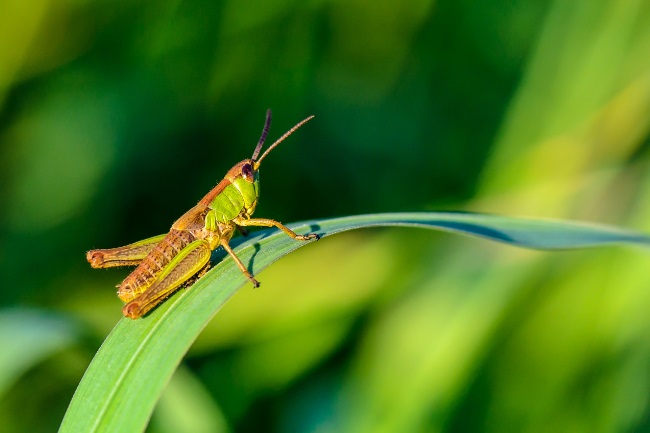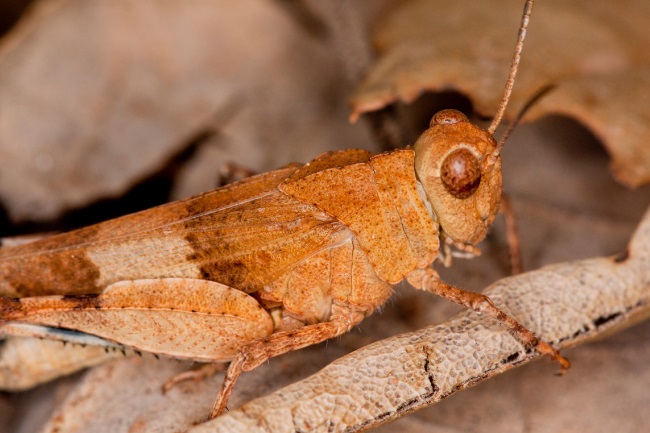Grasshoppers are famous for their song, playing their homemade fiddle into the evening air. They create this sound by rubbing their back legs across their wings. A few species do so by snapping their wings. They can also make a noise with their mouths, which is a much quieter chirruping sound.
Contents
What’s that singing?

We all love that sound of summer with the insects’ chirruping away as if to celebrate the warmth and beauty. Yet there’s more than one insect that will sing it’s heart out if given a chance. The two that are particularly famous for it are crickets and grasshoppers.
These two insects are often confused, looking very similar in lots of ways. Both come in a variety of shapes and sizes and colours, but there are distinct anatomical differences. The easiest to spot without in-depth knowledge is that crickets have a longer antenna than grasshoppers.
How do they make noise?

Another difference between crickets and grasshoppers is how they make noise. In general, crickets form their percussion by rubbing their back legs against their wings, whereas crickets make it by rubbing their wings together. However, nature never likes things too neat, so some grasshopper species do make music with their wings.
The most common process that grasshoppers use to create their song is very much like a scraper instrument, where you run a stick across a piece of wood cut through with several ridges. The grasshopper’s back legs are covered in these small raised bumps. In order to produce their song, they rub these along the veins on their wings. The wings help to amplify the sound. Additionally, the different arrangements of notches on various species produce different sounds. This type of way of making sound is called stridulation.
| Mechanism | Description |
|---|---|
| Stridulation | Rubbing body parts together to create sound |
| Wing Flicking | Rapid movement of wings to produce sound |
| Drumming | Vibrating body against a surface to create rhythmic sounds |
| Vocalization | Producing sound through specialized structures |
The second type of sound production, that a small number of grasshoppers practice, is crepitation. This is where the wings are pulled taut and effectively snapped. While crickets tend to create sounds with their wings while on the ground, those grasshoppers that practice crepitation do it during flight. The banded grasshoppers are an example of this. The sound is more like a crackle or popping and is utilised during the mating process; therefore, it isn’t made with every flight. Most of these grasshoppers can also stridulate.
As well as the sounds they make with their legs and wings; grasshoppers can also chirrup using their mouths. These sounds tend to be a distress signal aimed at scaring away predators. Though they might not seem so scary to us, it’s thought that the hollow bones of birds might help resonate with the sound if the insect is caught, making it seem louder and more frightening to the animal.
Also read: What Do Grasshoppers Drink? (Liquid of Choice)
When and why do they make noise?
Contrary to popular belief, female grasshoppers also often sing. However, they do it much quieter than the males. It’s been found that the female sometimes copies the male’s song during the mating ritual. Males are the ones that tend to get noticed by humans, singing out into the evening from high perches in the grass. The primary reason they do this is to attract a lovely lady.

Unlike crickets, most grasshoppers are active during the day. This, therefore, tends to be when they sing. Most species only manage to live a year, with the summer being the point when they reach maturity and are ready to mate. This is why the grasshopper’s call is synonymous with a hot summer’s day.
We may not immediately notice a difference in the tone, rhythm or pitch of different grasshopper songs, but they are often very species-specific, with other species having different songs. Additionally, they will play a range of tunes depending on what they aim to accomplish with them.
| Characteristic | Description |
|---|---|
| Frequency Range | Range of frequencies produced by grasshoppers’ sounds |
| Sound Intensity | The loudness or volume of the produced sound |
| Pulse Rate | Number of pulses or repetitions per unit of time |
| Species Variability | Variation in sound patterns among different grasshopper species |
Grasshoppers will often sing fairly steadily when they are on their own, hoping that a special lady might hear them and coming hopping, but their song will get more intense and louder if there’s another male singing nearby or if they spot their female. They even have a particular song that they might play the female just before courtship, a flourish to seal the deal.
Amazingly research has found that female grasshoppers can glean important health information from a male’s song. It seems they can get an understanding of his physical health and immune system. As the female must invest more of her time and energy into the reproduction process, she’s highly selective as to which male she’s happy to be the father of her young.
Noise can also be used defensively. A loud chirrup or a burst of music can surprise and frighten a lot of predators. In general, grasshoppers use this defence to warn other insects to move away, often falling silent when approached by larger predators; deciding hiding or fleeing is a much better strategy when faced with such imposing foes.
It’s also been found that grasshoppers sing louder and higher when it urban locations. This is because they are trying to make themselves heard over the sound of the traffic, which comes in at a similar pitch to some parts of their song.
Different songs for different species

The bow-winged grasshopper has been found to be a great duet, with the male building a song of increasing intensity punctuated in pauses. These cues eventually cause the female to respond to his songs.
The Boll’s and Carolina grasshopper is a species found across the East of America and one of the species that used crepitation during its mating ritual. It flies around in a butterfly-like style, trying to impress the female with its song. It is found mainly in dry areas with bare ground.
The common field grasshopper is found in gardens, meadows and heathlands throughout Europe, Africa and temperate Asia. It stipulates creating short chirrups to attract its female rather than a longer song. As with many species, the female will respond by echoing the male’s song.
By comparison to the common field grasshopper, the common green grasshopper has a very long song, lasting around 20-40 seconds. The sound is more of a ticking than an elongated note, which becomes louder and more rapid as the song progresses. The grasshopper is commonly found in wet habitats throughout Europe.
The King of the Grass
It is amazing how such little creatures as grasshoppers, crickets and cicadas can fill our world with noise to such an extent that hearing them sets the scene for us almost immediately, painting a hot summer’s days somewhere wild and beautiful.
Though we may only hear a cacophony of sound, it’s important to remember that these little insects are talking to each other, advertising their strength and suitability for courtship, challenging or responding. They use these sounds to locate each other, scare away predators and show off.
The songs are individual and changing, even to the extent that the same species can sing a different song in different countries. We may not always be clever enough to hear these differences, but the grasshoppers can, and after all, it’s them that need to listen.

